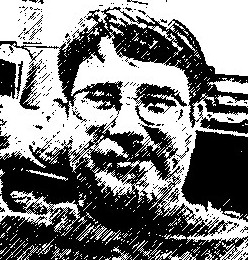My last DZ126 Digitrax DCC decoder has been installed into the
SD7 SD9 (explanation below).
There were a few things that were kinda screwy, and it's probably all my fault anyway but I did get everything straightened out.
First off, when wiring in a decoder the red wire goes to the right side pickups of the locomotive and the black wire goes to the left. The motor brush that once was connected to the right gets the orange wire and the other motor brush gets the gray wire.. The blue wire goes to both headlights, the yellow wire goes to the back light and the white wire goes to the front light.
Before the mod the bottom brush on the locomotive was connected to the right contacts and the top brush was connected to the left contacts. I wired up the decoder as specified with the orange wire to the bottom motor contact and the gray to the top motor contact, and then I put it on the track.
Operating in DC mode the lights did not come on at all, which I thought was kind of screwy but OK. Then I connected the DCC controller and programmed the loco...and the wrong headlight came on. The motor however ran just fine, just like it was supposed to, so no big deal. Back to the soldering bench, reverse the yellow and white wires and now the headlight on the leading end of the locomotive comes on when it is supposed to.
However, there was another problem, and the headlights should have clued me in. You see, when I actually paid attention to the NCE controller display I found the locomotive was running backwards.
How this happened I have no idea, but
the instructions were clear so I should have known; the instructions clearly state to connect the gray wire to the bottom motor tab and the orange wire to the top (the link goes to a TCS decoder installation page but the wire colors are identical). Why the locomotive ran properly in DC is anyone's guess, perhaps I was incorrect in thinking the red side contacts were the positive leads.
At any rate the issue is easily solved, back to the programming track and change the locomotive direction bit (CV29 bit zero) and all is well. This bit is supposed to be used to reverse the direction of the loco in consists or when you want to run it backwards; IE
if it is designed to run long hood forward like the SD9.
In my case I wanted the loco to run short hood forward; if I had wired the motor correctly it would have and I would not have had to swap the lights. The direction bit isn't supposed to be used to correct motor wiring, but since I had already switched the headlight wiring it worked out.
Or maybe, since the only difference between the SD7 and the SD9 was the prime mover (the diesel motor), and since (according to the
Wikipedia article) Burlington locomotive 346 is actually an SD9, I had it wired correctly all along...except for the original headlight wiring, which was incorrect because I mistakenly thought the short hood was the front.
UPDATE: Or not...the F on the short hood end indicates the front, which means I did have the motor wired backwards to begin with...and now the headlights too. Of course. And, the locomotive is clearly marked as an SD9. And also of course, the answer was right there all along.
Anyway, it now has a decoder, the decoder works, it programmed correctly, and I have it running in the direction I want it to run. Also, with the previously
DCC'd K4, the entire railroad is now DCC when running the usual locomotives, and I now have seven locomotives I can run on the club tracks (well, six actually since the first loco I successfully converted, a
Model Power Pacific, is in for repaint).
And now I am all out of decoders, at least until the broken one returns from Digitrax. I haven't yet decided what my next victim will be...




